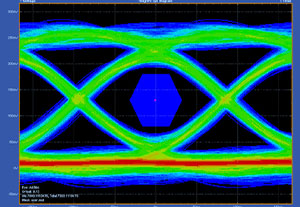Double Data Rate (DDR)
What Is Data Double Rate?
Double Data Rate (DDR) is a type of memory technology used in computers and other electronic devices to increase performance. DDR, a.k.a DDR SDRAM (Synchronous Dynamic Random Access Memory), stands for Synchronous Dynamic Random Access Memory, which means that the memory is synchronized with the system clock and can access any memory location in a random order. Technological advancements and innovations demand more extensive and faster memories to write, store, and retrieve large amounts of data. DDR has evolved over the years to meet the insatiable demands for performance and speed. It has significantly increased storage density and speed and reduced cost.
How Does Double Data Rate (DDR) Work?
Double Data Rate transfers data on the rising and falling edges of the clock signal, allowing for faster data transfer rates. Each major revision of the DDR standard has roughly doubled the memory bandwidth.
The basic building block of DDR memory is the memory cell, composed of a storage capacitor and a transistor. The storage capacitor holds the charge representing the data stored in the memory cell, while the transistor controls the flow of charge to and from the storage capacitor. When data is written to DDR memory, the charge on the storage capacitor is changed to represent the data. The data is stored in the memory cell at a voltage level, with a high voltage representing 1 and a low voltage representing 0. When data is read from DDR memory, the voltage level on the storage capacitor is measured, and the data is read as “1” or “0,” depending on the voltage level.
DDR employs double pumping technology to enable data transfer on both the clock cycle edges to double the bandwidth of the data bus. This allows DDR memory to transfer data twice as fast as SDR memory, significantly increasing the device’s performance. The transfer rate of DDR memory is measured in MHz, with higher transfer rates indicating faster performance.
DDR memory is used in many devices, including personal computers, servers, gaming consoles, and mobile devices. In personal computers, DDR memory is used as the main memory and is responsible for storing the operating system, applications, and data that are currently in use. In addition to its use in computers, servers, and other electronic devices, DDR memory is also used in other applications, such as automotive systems and industrial automation.
Benefits of DDR
DDR is a type of memory technology that offers several benefits over SDR memory:
- Faster data transfer rates: DDR memory can transfer data on both the rising and falling edges of the clock signal, allowing faster data transfer rates than SDR memory.
- Increased bandwidth: The faster data transfer rates of DDR memory also result in increased bandwidth, which is the amount of data that can be transferred in a given period. Therefore, DDR memory can handle more data at once, which is particularly useful for devices that require high performance, such as servers and gaming consoles.
- Improved power efficiency: DDR memory is more power-efficient than SDR memory, which means that devices that use DDR memory will consume less power and generate less heat. This is particularly useful for mobile devices, which need to conserve power to last longer on a single charge.
- Higher capacity: DDR memory is available in different versions, such as DDR1, DDR2, DDR3, DDR4, and DDR5; each version has different capacity specifications. For example, DDR1 memory has a maximum capacity of 1 GB, while DDR4 memory has a maximum capacity of 16 GB. Therefore, devices that use DDR memory can store more data than devices that use SDR memory.
- Synchronized with the system clock: DDR memory is also known as DDR SDRAM (Synchronous Dynamic Random Access Memory), which means that the memory is synchronized with the system clock.
- Widely used in various applications: DDR memory is used in many devices, including personal computers, servers, gaming consoles, and mobile devices. It is also used in other applications, such as automotive systems and industrial automation, making it a versatile technology with many uses.
Overall, DDR memory offers several benefits over standard SDR memory, including faster data transfer rates, increased bandwidth, improved power efficiency, higher capacity, synchronization with a system clock, and its wide use in various applications.
DDR and Cadence
Cadence Denali Memory and Storage IP solutions support the broadest industry standards with controller and PHY implementations for high-performance and low-power applications. Take advantage of widely used memory and storage protocols, including the latest DDR, LPDDR, GDDR, NAND Flash, xSPI, and SD/eMMC standards. Complete characterization reports back robust hard PHYs for high-performance apps, while firm PHY options provide flexibility.
DDR/LPDDR PHY and Controller – Flexible High-performance multi-protocol IP
DDR PHY and Controller- Cadence Denali DDR solutions are a family of high-speed on-chip interfaces. IP is leading the way for high-performance computing (HPC) systems and data center applications. The DDR PHY IP is engineered to quickly and easily integrate into any system-on-chip (SoC) and is verified with the Denali DDR Controller IP as part of a complete memory subsystem solution.
LPDDR PHY and Controller - The world-class Cadence Denali LPDDR PHY and controller memory IP is highly flexible and can be configured to support a wide range of applications and protocols.
GDDR PHY and Controller - The Cadence IP solution for GDDR6 consists of PHY and controller serving high-bandwidth memory applications. The solution is ideal for applications including artificial intelligence and machine learning (AI/ML), graphics, autonomous driving (ADAS), and targeted high-performance computing (HPC).
Storage IP - Cadence Denali Memory and Storage IP solutions support the broadest range of industry standards, with controller and PHY implementations for both high-performance and low-power applications. Cadence Storage IP has solution offerings for raw (unmanaged) and managed NAND flash, NOR flash, and novel memory architectures. Take advantage of widely used memory and storage protocols, including the latest DDR, LPDDR, NAND Flash, Octal SPI, Quad SPI, and SD/SDIO/eMMC standards, and get the added value of configurability and customization support for your specific needs.
Denali Controller IP for DDR - The Cadence Denali Controller IP for LPDDR5/4X/4/3 and DDR5/4/3L/3 provides low latency and up to 5500Mbps throughput, while supporting extensive value-added features including, but not limited to, reliability features.

